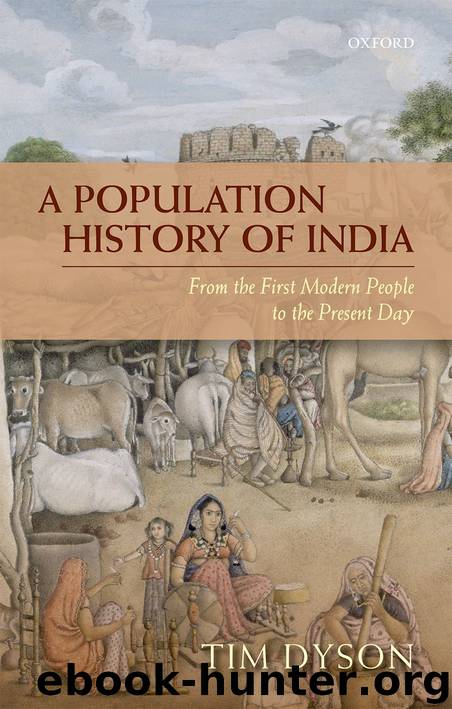A Population History of India by Tim Dyson

Author:Tim Dyson
Language: eng
Format: epub
ISBN: 9780192564306
Publisher: Oxford University Press
Published: 2018-09-02T16:00:00+00:00
Migration
Data from the early censuses of India show that most migration was ‘rural to rural’ and that it occurred over fairly short distances. Especially in the north, migration often reflected women moving to join their husbands at the time that their marriages were consummated. According to the 1881 census, 97 per cent of people for whom ‘place of birth’ was recorded were enumerated in the same province (or state) in which they were born (a figure that was not much different in 1971).109 Of course, comparison of information on people’s place of birth with their place of enumeration provides only a crude indication of migration. Nevertheless, Kingsley Davis was right to observe that the population was not very mobile. He explained this with reference to people’s low levels of education, mainly agricultural livelihoods, the influence of joint family structures, and high levels of marriage endogamy within castes. He also reasoned that the country’s cultural and linguistic diversity acted to inhibit movement.110
In relation to internal migration over longer distances, comparison of early census data on place of birth and place of residence reveals signs of migration flows that would grow substantially in later decades. In particular, the middle and lower Ganges basin were areas that tended to export people. Thus there was migration out of United Provinces towards Delhi and its environs, and out of Bihar towards Bengal—especially the industries of Calcutta. There was also westward movement towards the urban centres of Bombay Presidency.111
So far as long-distance migration to rural destinations was concerned, Assam’s population grew rapidly during 1871‒1921.112 People moved to Assam either to work in the foreign-owned tea estates (on contracts similar to those of indentured labourers) or to establish small farms in the province’s fertile river valleys. Many of the tea estate workers came from Odisha and the Chota Nagpur region of Bihar. Their living conditions on the estates were dire, and they experienced high mortality—for example, from cholera, malaria, and kala-azar. Many of the workers returned home at the end of their contracts, although some remained and worked small landholdings. However, most of the people who established farms in Assam came from eastern Bengal (especially Mymensingh district) where, as noted, there was ‘high natural increase’ and therefore increasing pressure on agricultural land. Migration from eastern Bengal into Assam seems to have begun abruptly, and then grown rapidly in the first decades of the twentieth century. The migrants settled mainly in the Surma and Brahmaputra river valleys.113 Writing in the 1940s Arthur Geddes observed that ‘Assam is a land of ancient Hindu culture which is being “colonised” by Muslim peasantry’.114
In fact, ‘colonization’ was one of the main patterns of population growth variability identified by Geddes. As well as in Assam, this pattern of growth typified the tea estate areas of central Sri Lanka—where most of the labour force were Tamils from the mainland. In addition, colonizing migration prevailed in the vast, government-sponsored, canal projects of Punjab. Between 1888 and 1921 the area under canal irrigation in Punjab rose from under one million hectares to over four million hectares.
Download
This site does not store any files on its server. We only index and link to content provided by other sites. Please contact the content providers to delete copyright contents if any and email us, we'll remove relevant links or contents immediately.
Cecilia; Or, Memoirs of an Heiress — Volume 1 by Fanny Burney(32434)
Cecilia; Or, Memoirs of an Heiress — Volume 2 by Fanny Burney(31871)
Cecilia; Or, Memoirs of an Heiress — Volume 3 by Fanny Burney(31856)
The Great Music City by Andrea Baker(31357)
We're Going to Need More Wine by Gabrielle Union(18967)
All the Missing Girls by Megan Miranda(15575)
Pimp by Iceberg Slim(14394)
Bombshells: Glamour Girls of a Lifetime by Sullivan Steve(13975)
Talking to Strangers by Malcolm Gladwell(13222)
Norse Mythology by Gaiman Neil(13207)
Fifty Shades Freed by E L James(13157)
For the Love of Europe by Rick Steves(13000)
Mindhunter: Inside the FBI's Elite Serial Crime Unit by John E. Douglas & Mark Olshaker(9201)
Crazy Rich Asians by Kevin Kwan(9167)
The Lost Art of Listening by Michael P. Nichols(7408)
Enlightenment Now: The Case for Reason, Science, Humanism, and Progress by Steven Pinker(7235)
The Four Agreements by Don Miguel Ruiz(6632)
Bad Blood by John Carreyrou(6552)
Weapons of Math Destruction by Cathy O'Neil(6146)
